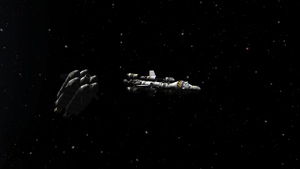Difference between revisions of "Tutorial:How to get to Eve/zh-cn"
(→第2步-对准行星) |
(→第2步-对准行星) |
||
| Line 39: | Line 39: | ||
===第2步-对准行星=== | ===第2步-对准行星=== | ||
| − | + | 尽管不是绝对必要,但从Kerbin到达Eve的最简单,最快的方法是确保它们正确对齐。否则,您可能会花费很多时间(可能是数年),并且浪费大量Dv,除非碰巧匹配。 | |
要做到这一点,请检查您的星图,并确保Eve在绕[[Kerbol]]轨道上'''落后于'''Kerbin,而且Eve-Kerbol连线和Kerbin-Kerbol连线之间的夹角约等于60°。 | 要做到这一点,请检查您的星图,并确保Eve在绕[[Kerbol]]轨道上'''落后于'''Kerbin,而且Eve-Kerbol连线和Kerbin-Kerbol连线之间的夹角约等于60°。 | ||
Revision as of 14:03, 27 September 2024
| 这一页面需要更新 请帮助Kerbal Space Program Wiki 更正 不准确或过时的信息. |
Contents
Traveling to Eve
Eve是距离Kerbin最近的行星,因此最容易到达。然而,由于Eve强大的引力和浓密的大气,从Eve返回要困难得多。如果您经验丰富,并且相当勇敢,则可能需要有关从Eve返回的教程
规格
- 时长: 1–3小时
- 难度: 中等/难
- 版本: 0.17
此外,您需要对轨道力学(请参阅教程部分),角度和很多耐心有很好的理解。
步骤
第1步-造火箭
要在Eve上成功降落,您需要一艘大型飞船。您可以一次用一颗巨大的火箭将其发射,也可以将中层和高层分别发射到轨道,然后将它们对接在一起。
上层
如果要着陆,请仅考虑建造一个较高的平台。它至少应包括可以着陆在表面上的着陆器。您可能还需要考虑带一些额外的燃料,以防万一:
A:您的中层无法将您拉出Eve的轨道。
B.您希望它能够飞回轨道执行返回任务。
如果您要着陆,由于大气层较厚,您将不需要像在Kerbin着陆那样所需的降落伞。您可能需要考虑着陆火箭,以防万一您失去滑道。如果您正认真计划回家,那么这一级将需要非常大的火箭。
中层
这是您要从Kerbin轨道飞到Eve轨道的阶段,并且可能会减速成受控下降的阶段。建议此阶段保持轻便,因此建议在行程中使用具有高比冲的推进器,例如LV-909液体燃料发动机或理想的核发动机。
下层
如果您希望到达Eve,这个阶段至少应该带您进入Kerbin的轨道。可能需要一些大型推进器才能将行星际飞行器本身提升到轨道上,这可能需要某些SRB的协助。
第2步-对准行星
尽管不是绝对必要,但从Kerbin到达Eve的最简单,最快的方法是确保它们正确对齐。否则,您可能会花费很多时间(可能是数年),并且浪费大量Dv,除非碰巧匹配。
要做到这一点,请检查您的星图,并确保Eve在绕Kerbol轨道上落后于Kerbin,而且Eve-Kerbol连线和Kerbin-Kerbol连线之间的夹角约等于60°。
更简单的方法就是访问以下网站The Interplanetary Guide and Calculator (在这个网站,你可以方便地计算出各行星的最佳发射窗口和点火加速时的角度)
Step 3 - Launch to Kerbin Orbit
Take off as usual into an eastward orbit (see Tutorials for how to achieve orbit). Unless you've done your own calculations, try to aim for a circular equatorial orbit at around 200,000 meters.
Step 4 - Fly from Kerbin to Eve
If you have successfully reached your desired orbit around Kerbin, begin your high-velocity burn. Keep an eye on your map, as mentioned above you will need to wait until Kerbin sits exactly between you and Eve, and get your velocity up to approximately 3060 m/s.
It's really important to watch the map while you are accelerating. As you accelerate your Kerbolar orbital path should move to intersect Eve's. If all goes well, there should be a brief moment where you are captured by Eve's gravity well right around the target velocity. Immediately cut your thrust. If you overshoot, just turn the craft around and do a slight retro burn until you are caught again.
Your orbit will probably be a bit higher or lower than Eve's. Just warp to the next ascending/descending node (If you don't have one, make sure you have set Eve as your target) and burn until both nodes are at 0.
This journey should take about 200+ days, so hit the warp key and enjoy the ride.
Step 5 - Arriving at Eve
When you enter Eve's sphere of influence you will almost certainly be travelling at escape velocity. If you have the fuel, simply burn retrograde at periapsis until you are in some kind of orbit.
You can greatly reduce the amount of fuel required to achieve an orbit around Eve by aerobraking. As shown on the information page, Eve's atmosphere begins around 90 km, so if you pass Eve with a periapsis slightly lower than that, the atmosphere will bleed off some speed before you retro burn in to an orbit.
You can continue to lower your orbit with aerobraking by keeping your periapsis slightly below 90 km. If you are not planning on landing, execute a prograde burn at apoapsis to raise your periapsis above the atmosphere once your apoapsis is low enough. Unless you have escape velocity or an extremely wide orbit (Or a good Heat shield and radiator panels), going below 80 km will probably result in overheating.
Step 6 - Land on Eve (Optional)
Adjust your orbital path to where you would like to land, and continue aerobraking to bleed off that extra velocity. Eventually you will be caught on a terminal descent through the atmosphere. You will notice that due to the thicker and larger atmosphere than Kerbin's you will descend much more slowly. Deploy your chute(s) to slow down even further. Lower whatever landing gear you brought with you and fire retrorockets if the chutes aren't slowing you down enough. Ultimately we're going for a typical touchdown speed (6–12 m/s).
Congratulations! You've landed on Eve!

